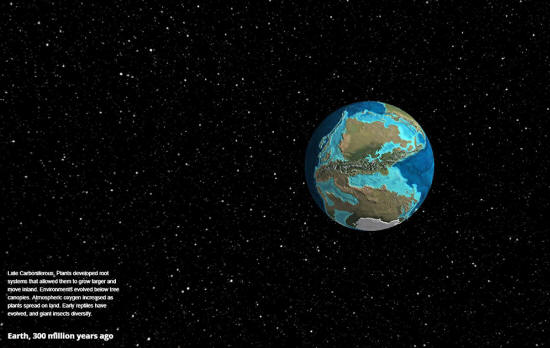|

by Ivan Petricevic
May 06, 2018
from
Ancient-Code Website

Earth 600 million years ago.
Image
Credit: dinosaurpictures.org
A stunning new interactive map lets you travel back in time and see
how our planet's continents have changed through more than 600
million years.
The ancient Earth Globe lets viewers appreciate how Earth's
continents have transformed while ocean levels advanced and receded
through 600 million years of our planet's history.
The stunning map was built using research gathered by Northern
Arizona University. According to one of the interactive map's
creators, a former Google engineer, it shows how humans are ‘just a
blip in history.'
The stunning map allows you to travel through 600 million years of
our planet's history.
To understand what occurred at a certain time,
the map features a small description of the period you are currently
viewing.
For example, if we decide to see what the Earth looked like 600
million years ago, the ancient Earth Globe map tells us that we are
looking at the
Ediacaran Period.
Life is evolving in the sea, and multi-cellular life is just beginning to emerge.
In the menu, we can scroll through different ages.
560 million years
ago, we see the Late Ediacaran. Life is evolving in the sea, and
multi-cellular life is just beginning to emerge.
A mass extinction is about to take place, tells the map while we see
an unrecognizable Earth.
500 million years ago we traveled to the
Late Cambrian.
The
interactive map explains how the ocean is teeming with life
following a dramatic expansion of animal diversity in the sea, known
as the "Cambrian explosion."
The forms of some animals show ancestry
to modern animals.
Traveling further in time, we decided to stop by and see how our
planet looked like 430 million years ago, during the
Silurian
Period.
The interactive map tells us that a mass extinction took place,
wiping out nearly half of marine invertebrate species. The first
land plants emerge, starting at the edge of the ocean.
Plants evolve
vascularity,
the ability to transport water and nutrients through their tissues.
Ocean life becomes larger and more complex, and some creatures
venture out of reefs and onto land.

Our planet as seen 300 million years ago.
Image
Credit: dinosaurpictures.org
300 Million years ago we arrived at the
Late Carboniferous.
Plants developed root systems that allowed them to grow larger and
move inland.
Environments evolved
below tree canopies. Atmospheric oxygen increased as plants spread
on land. Early reptiles have evolved, and giant insects diversify.
Earth still looks unrecognizable.
If we travel to 200 million years ago, to the
Late Triassic, we see
a more familiar planet, although continents we see today have still
not formed.
During the Late Triassic, an extinction event is about to happen,
resulting in the disappearance of 76% of all terrestrial and marine
life species and significantly reducing surviving populations.
Some
families, such as pterosaurs, crocodiles, mammals, and fish were
minimally affected.
The first true dinosaurs emerge.
Earth, 105 million years ago, during the
Cretaceous period begins to
take a more familiar shape. During this period, Ceratopsian and
pachycephalosaurid dinosaurs evolve.
Modern mammal, bird, and
insect groups emerge.
20 million years ago we see planet Earth during the
Neogene Period
where mammals and birds continue to evolve into modern forms. Early
hominids emerge in Africa.
Check out the map and enjoy scrolling through Earth's long history:
The map offers a unique educational experience.
This will surely help
us understand not only how continents have shifted and changed
through history, but it will also help us understand how they will
continue doing so.
|


